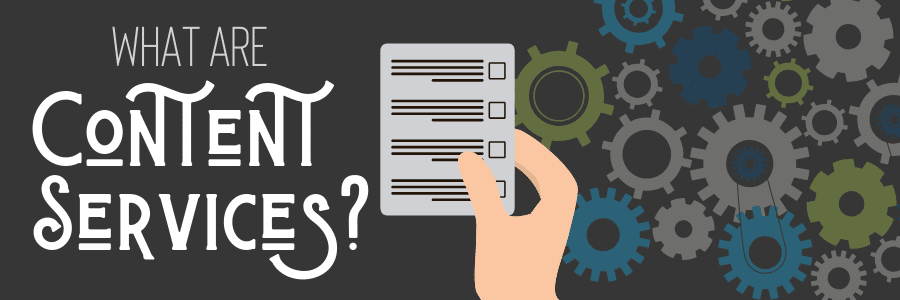By Layne Alfred, Marketing Associate
It was difficult enough getting everyone on the same page of the definition of ECM, which AIIM defines as “the systematic collection and organization of information that is to be used by a designated audience – business executives, customers, etc. It’s neither a single technology nor a methodology or process, it’s a dynamic combination of strategies, methods, and tools used to capture, manage, store, preserve, and deliver information supporting key organizational processes through its entire lifecycle.”
But now that ECM is supposedly dead and Content Services is the new “it” term, there is new confusion as to how this new term is different and why it’s important. What exactly is content services? Gartner defines content services as “a set of services and microservices, embodied either as an integrated product suite or as separate applications that share common APIs and repositories, to exploit diverse content types and to serve multiple constituencies and numerous use cases across an organization.”
Content services represents a new way of thinking about how content and data should be managed in a business environment. In the past with “ECM,” the importance of managing content was mostly placed on how it would be stored and organized. Content services prioritize insights that can be extracted and analyzed from the content. It’s all about how businesses can use that data and get the most value they possibly can from it. The way your content is managed (everything that you do with your content) should be determined by your business strategy and current initiatives, not just how to get all your content on a singular platform.
Content services encompasses platforms, applications and components that manage content including services and microservices. This is not to be confused with Gartner’s term “content services platform,” which is what they dubbed the replacement term for ECM. Some companies have multiple platforms for content services, some have one, some have none and just have disparate applications. This means that the umbrella of content services includes:
 Platforms
Platforms
Content services platforms have their own repositories and can integrate with other repositories. These platforms execute document management, workflow, capture, analytics and other content services software.
 Applications
Applications
Content services applications are solution-based that focus on specific use cases. Our life underwriting solution, for example, would be considered an application of content services. These often work to solve specific industry or business challenges as well.
 Components
Components
Content services components extend the capabilities of the application or platform on which you’re working. Components add functionalities to an application such as automated bookmarks.
So, why is it important for businesses to acknowledge this shift? Here are just a couple reasons:
Cooperation between IT and business operations is more important now than ever before.
Content services promotes a strong relationship between these two. Rather than IT in the driver’s seat deciding how the business should manage content, the power is shifting more towards business operations to help drive innovation. Imagine a spectrum that illustrates the level of technological decision-making with IT on the left and business units on the right. The marker is closer to the middle of the spectrum than it has ever been. Since operations are now looking to technology and IT solutions to meet business needs, both sides of the house need to work together to understand each other’s objectives in order to find the solutions that are best for the entire organization.
Multiple content services repositories and platforms that serve different functions.
As the use of content within organizations began to evolve to serve various business requirements, it became burdensome to manage everything from a single repository. Since the definition of content services includes platforms, applications and components, the term itself encourages businesses to manage content in whatever way supports their goals and needs. The flexibility that content services offer organizations allows for a more strategic approach to managing content.
Like ECM, content services are all about empowering your employees, but in a different way.
Since managing content in different platforms and applications allows managers to customize workspaces based on departments’ objectives, employees are empowered with the information they need to make good decisions and aren’t burdened with information they don’t need. With more personalized applications, employees can work faster and spend more of their time on revenue-generating activities. In the same vein, this approach makes it easy for employees to share and retrieve information. Content services can automate the movement of content across the entire organization as well as intelligently categorize information for easy searching.
The use of content services doesn’t mean any huge changes need to happen with the way your organization manages content. You don’t need to migrate all your content and invest in new platforms. It’s simply about taking a strategic approach to your content rather than forcing all your content to comingle in one location for reasons that don’t work for your specific business processes.
Take a look at our white paper, Accelerated Underwriting: Pieces for Foundational Success to see how content services applications modernize and increase efficiency in the insurance industry.

Layne Alfred
Marketing Associate

